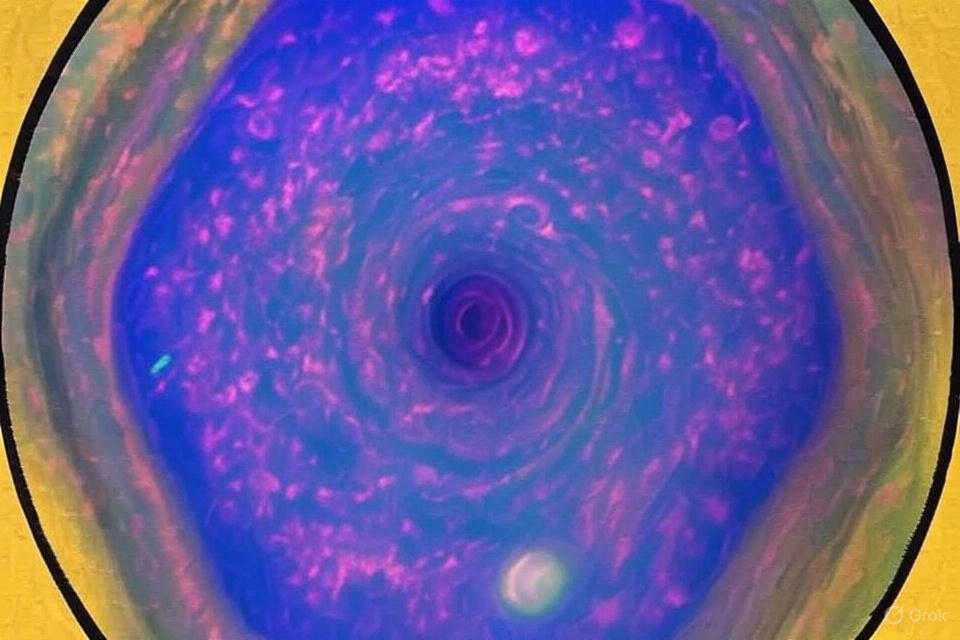James Webb Telescope Reveals Unexplained Structures in Saturn’s Atmosphere
Introduction
On September 23, 2025, a viral post by @MAstronomers on X (formerly Twitter) announced a remarkable discovery: the James Webb Space Telescope (JWST) had detected unexplained structures in Saturn’s atmosphere. The post included a mesmerizing image of a swirling polar vortex and has since sparked widespread discussion in both scientific communities and among space enthusiasts.
This breakthrough underscores how advanced space telescopes continue to unveil the mysteries of our solar system, offering insights that were previously impossible with earlier missions like Cassini.
The Tweet and Its Context
The tweet (Post ID: 1970477802248941703) stated:
"NEWS🚨: James Webb Telescope just detected unexplained 'structures' in Saturn’s atmosphere"
Montage of stills from animation showing the dark, bead-like features embedded in bright auroral halos as Saturn rotates beneath JWST’s view. Credit: NASA/ESA/CSA/Stallard et al 2025. pic.twitter.com/oNWCnTfNGb
— Curiosity (@MAstronomers) September 23, 2025
The image accompanying the tweet shows a vibrant hexagonal vortex in Saturn’s north pole, with swirling purples, blues, and pinks. While initially attributed to JWST, experts clarified it’s a false-color Cassini image, highlighting the planet’s polar storm.
Despite the image origin, the scientific data behind the announcement is genuine, making it a groundbreaking moment in planetary astronomy.
What JWST Actually Detected
According to the detailed thread, JWST’s Near-Infrared Spectrometer revealed:
- Dark bead-like shapes in Saturn’s ionosphere, around 1,100 km above the surface.
- A star-shaped asymmetric feature in the stratosphere, approximately 500 km high.
These features appear aligned across different atmospheric layers, suggesting a potential connection. Scientists speculate links to Saturn’s hexagonal storm or interactions between the planet’s magnetosphere and auroral activity.
This observation during Saturn’s equinox—a rare occurrence every 15 years—offers an extraordinary opportunity for further study.
Scientific Significance
- Atmospheric Dynamics: Shows complex interactions in Saturn’s upper atmosphere.
- Infrared Observation Power: Demonstrates JWST’s ability to detect subtle features invisible to past missions.
- New Research Opportunities: Enables scientists to explore unknown processes in gas giant atmospheres.
Presented at EPSC-DPS2025 (European Planetary Science Congress and Division for Planetary Sciences), the findings highlight the ongoing surprises our solar system holds.
NEWS🚨: : James Webb Telescope just detected unexplained “structures” in Saturn’s atmosphere pic.twitter.com/WtlGjTzQ5L
— Curiosity (@MAstronomers) September 23, 2025
Public Reaction
- Experts clarified the image origin, preventing misconceptions.
- Enthusiasts jokingly suggested extraterrestrial influences.
- The tweet generated massive engagement, emphasizing society’s fascination with space discoveries.
FAQs
Q1: Is the image from JWST?
A1: No, the image is a false-color Cassini photo, used to illustrate Saturn’s polar vortex. The JWST data is based on infrared spectrometry.
Q2: What makes these structures unusual?
A2: Their alignment across altitudes and asymmetric shapes are unexpected, hinting at unknown atmospheric processes.
Q3: How rare is Saturn’s equinox?
A3: It occurs every ~15 years, providing limited observation windows for atmospheric phenomena.
Q4: Can these findings indicate life or aliens?
A4: There’s no evidence supporting extraterrestrial life. The structures are atmospheric features.
Conclusion
The James Webb Telescope’s recent detection of unexplained structures in Saturn’s atmosphere reminds us that our solar system is far from fully understood. While images may mislead, the infrared data is authentic, revealing mysterious patterns in Saturn’s ionosphere and stratosphere.
These findings not only advance planetary science but also ignite curiosity and imagination worldwide. As follow-up studies continue, we can expect more revelations about the dynamic processes shaping Saturn—a planet that continues to challenge our understanding of the cosmos.
In short: Saturn’s atmosphere is a complex, ever-changing laboratory, and JWST has given humanity an unprecedented glimpse into its hidden mysteries. The more we explore, the clearer it becomes that even our closest planetary neighbors hold secrets waiting to be discovered.


0 comments